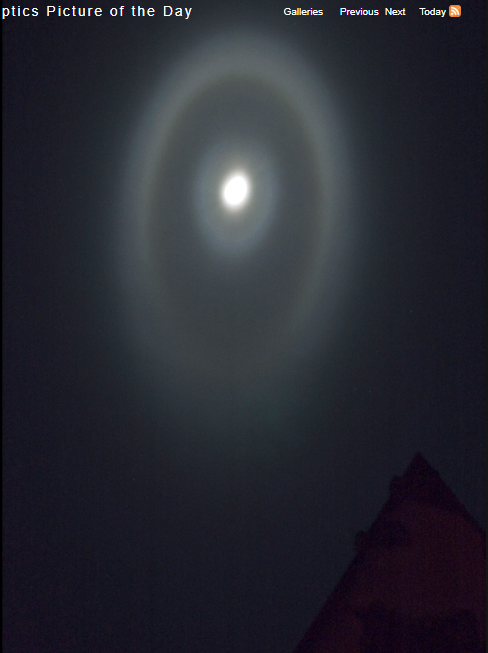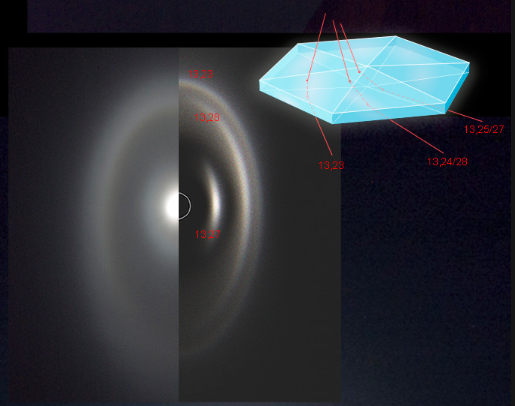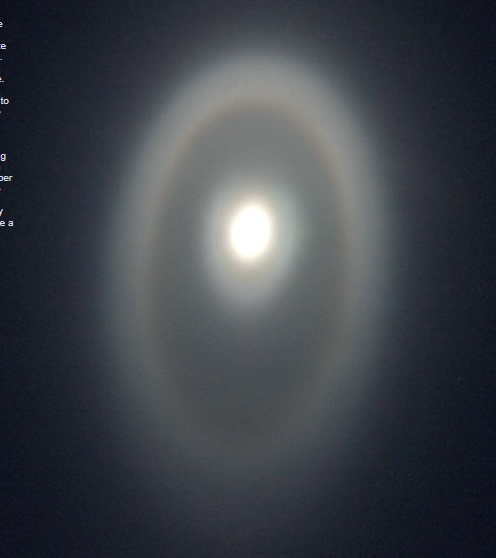Lunar Elliptical Halo
Lunar Elliptical Halo: A Mysterious and Rare Atmospheric Phenomenon
The lunar elliptical halo is a captivating atmospheric phenomenon that occurs when ice crystals in the air refract and reflect light, creating a series of oval-shaped rings around the moon. These halos are ephemeral, rare, and continue to puzzle scientists and observers alike. In this article, we will delve deeper into the enigma of elliptical halos, exploring their formation, characteristics, and the challenges faced in understanding them.
Guillaume Poulin's Remarkable Observation
One particularly stunning observation of an elliptical halo was made by astrophotographer Guillaume Poulin at Mont-Megantic National Park in Quebec, Canada. While taking astro photographs in frigid temperatures of -15 degrees Celsius, Poulin noticed the formation of tiny ice crystals falling like snowflakes and the emergence of a halo around the moon. Within minutes, another halo, twice the size of the first one, became visible. Despite the need for overexposure to capture the halos, the distinct shape of the 38° high moon remained apparent in Poulin's images.
The Elusiveness of Elliptical Halos
Elliptical halos are not only rare but also elusive. These halos are typically small, spanning only a few degrees across, and can feature two or three oval rings. While they are commonly observed in altocumulus clouds, Poulin's images suggest that crystals in ice fog may also contribute to their formation. However, due to limited observations and a scarcity of crystal samples, the analysis of elliptical halos has been significantly hindered.
Guillaume Poulin's Detailed Images
Guillaume Poulin's exceptional images provide valuable insights into the structure and characteristics of elliptical halos. The images reveal three rings in intricate detail, with the innermost ring possibly displaying a bluish hue and the second ring exhibiting a distinct reddish tint, indicating the role of refraction in their formation. Other notable features include variations in brightness around the rings and their slight offset from the moon. The presence of faint but identifiable stars in some images allows for precise measurements of the ring dimensions, aiding in further analysis.
Unraveling the Mystery of Formation
Despite the beauty captured in Poulin's images, the formation of elliptical halos remains an intriguing puzzle. Their small dimensions suggest that refraction may occur between crystal faces with only slight inclinations to one another, in stark contrast to the 60° inclination responsible for the more common 22° halo. One hypothesis proposes that flat pyramidal crystals, drifting horizontally like ordinary hexagonal plates, generate the rings. Similar crystals were also implicated in modeling Bottlinger's rings, another rare atmospheric optical phenomenon.
Ray Tracing Simulations and Crystal Properties
To better understand the formation of elliptical halos, researchers have conducted ray tracing simulations using HaloSim. These simulations aim to match the observed ring sizes and intensity variations. One simulation employed crystals with upper and lower pyramidal faces inclined at an angle of 3.5° from horizontal. While this crystal configuration yields a halo of the appropriate size and generates three rings similar to those observed, the fit is not as precise as desired. It suggests that additional iterations and adjustments to crystal properties are necessary to improve the accuracy of the model.
The Challenge Ahead
The study of elliptical halos presents a significant challenge for researchers. The formation of these halos demands crystals with unusual properties, and the predictions generated by current models do not entirely align with observations. The need for further investigations, including fine-tuning crystal angles, incorporating flat caps at the top and bottom of crystals, and exploring variations in crystal orientation, is evident. By embracing this challenge, scientists hope to deepen our understanding of these captivating and perplexing atmospheric optical phenomena.
In conclusion, the lunar elliptical halo is a rare and captivating atmospheric phenomenon that continues to intrigue scientists and observers worldwide. Guillaume Poulin's remarkable observation and detailed images offer valuable insights into the structure and characteristics of these halos. While much remains unknown about their formation, ongoing research and simulations aim to shed light on the enigmatic nature of elliptical halos. By unraveling their mysteries, we can further appreciate the beauty and complexity of our atmosphere's optical phenomena.

Lunar Elliptical Halo ~ Guillaume Poulin took this perhaps the finest image of an elliptical halo at Mont-Megantic National Park, Québec, Canada.
Guillaume had been taking astro photographs in a temperature of -15 Celsius. "On our way back home we noticed that the water vapor contained in the air began to form tiny ice crystals that were falling like snow flakes and at the same time a halo was forming around the moon. A few minutes later, another halo, twice the size of the first one was also visible." The 38° high moon was just past first quarter. It had to be overexposed to capture the halos but its shape remains apparent.
All images ©Guillaume Poulin, shown with permission.


Elliptical halos are rare, they are ephemeral and they are enigmas. They are likely related to the even more rare Bottlinger�s Rings superbly imaged in the previous OPOD.
Ellipticals are small halos just a few degrees across. They can have two or three oval rings. They are mostly seen in altocumulus cloud although here crystals in ice fog might be the source. The rings are of frustratingly varied angular size and likely depend on the solar or lunar altitude. The paucity of good observations and crystal samples has considerably hindered analysis.
Guillaume took several outstanding images. They show three rings in some detail. The innermost ring is perhaps bluish and the inside of the second ring has a definite reddish hue indicating that refraction has played at least some role in its formation. Other cues for a better understanding are the variation in brightness around the rings and the way that they are offset from the moon.
We are fortunate that some of his images show faint but identifiable stars allowing the ring dimensions to be measured very precisely. On a line through the moon the second ring is 5.6� across.
Do we understand how ellipticals are formed? Their small dimensions could imply refraction between crystal faces only slightly inclined to one another. That is in considerable contrast to the 60° responsible for the common 22° halo.
One possibility is that very flat pyramidal crystals produce the rings. The crystals are assumed to drift nearly horizontal in the same manner as ordinary hexagonal plates. The same crystals were invoked to model Bottlinger�s rings although other routes might also form the latter.
At right we have a ray tracing simulation made by HaloSim in an attempt to match the ring sizes and intensity variations. The simulation used crystals with upper and lower pyramidal faces inclined 3.5� from horizontal. This corresponds to face Miller Indices like 1,0,-1,35 which are crystallographically preposterous. Faces more usually follow planes of atoms or ions within the crystal lattices and yield Miller Indices with low integer values. One let out is to invoke snow-like crystals with ice wedges arranged dendritically..
The simple crystal yields a halo of the right size. There are three different ray paths through its faces which generate three rings not dissimilar to those observed. (The numbers are those of the faces traversed.)
The similarity is encouraging and the fit is OK - But not as good as that obtained when modeling other halo displays. It is tempting to think that a few more iterations - separately altering the upper and lower face angles, inserting flat caps at top and bottom and changing the wobble from horizontal will improve it. It doesn't - or not very much anyway. That�s the challenge. We have a theory demanding rather unusual crystals and predictions that are not quite right.
Download HaloSim and try it!
Note: this article has been automatically converted from the old site and may not appear as intended. You can find the original article here.
Reference Atmospheric Optics
If you use any of the definitions, information, or data presented on Atmospheric Optics, please copy the link or reference below to properly credit us as the reference source. Thank you!
-
<a href="https://atoptics.co.uk/blog/lunar-elliptical-halo/">Lunar Elliptical Halo</a>
-
"Lunar Elliptical Halo". Atmospheric Optics. Accessed on April 24, 2024. https://atoptics.co.uk/blog/lunar-elliptical-halo/.
-
"Lunar Elliptical Halo". Atmospheric Optics, https://atoptics.co.uk/blog/lunar-elliptical-halo/. Accessed 24 April, 2024
-
Lunar Elliptical Halo. Atmospheric Optics. Retrieved from https://atoptics.co.uk/blog/lunar-elliptical-halo/.